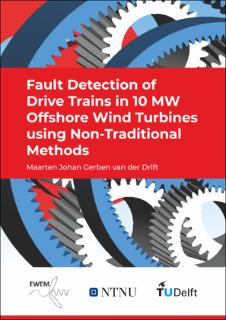| dc.description.abstract | One of the world’s biggest concerns is global warming, a solution to this can be wind energy.
Offshore wind energy has advantages over onshore wind energy, however, the levelized cost of
energy is higher. The maintenance costs are a major cost contributor. To lower these costs, research
is performed on faults and its detection. Currently, little is known about fault detectability and
vibration propagation in a drive train of an offshore wind turbine. Fault detection and vibration
propagation in a drive train of a 10 MW floating offshore wind turbine is therefore investigated
to get an insight about the effect of faults on the vibration monitoring data of a drive train. Three
different faults with five different degradation levels are applied one by one on the bearings of a
10 MW drive train model. These faults are radial and axial damage in the main shaft front bearing
and radial damage in the high speed shaft rear bearing. One traditional, two non-traditional and
two novel fault detection methods are used to detect faults and their vibration propagation.
One common and one novel fault detection method are deployed in the time domain: the Velocity
Root-Mean-Square (RMS) Threshold Method and the Peeters’ Anomaly Detection Method. The
Velocity RMS Threshold Method compares the RMS of the vibration velocity of non-rotating parts
with a threshold proposed by ISO 10816-21. The latter method makes use of statistical indicators
and is tailored for this study. Although changes after fault introduction were observable, the
methods can not be used and need to be altered for usage in the wind industry.
The non-traditional Angular Velocity Error Energy Method is deployed in the frequency domain.
It makes use of the angular velocity measurements from the drive train’s shafts and compares
the normalized energy of its spectra with a threshold. This method inspired the development of
novel fault detection methods introduced in this study, being the Bearing Velocity Energy Method
(making use of bearing velocity measurements and also based on the Velocity Root-Mean-Square
Threshold Method) and the Shaft Vibration Energy Method (making use of the velocity and acceleration
of shafts). Both methods compare the normalized energy of the spectra with a threshold.
Radial damage in the main shaft front bearing could be detected using the Angular Velocity Error
Energy Method, the Bearing Velocity Energy Method and the Shaft Vibration Energy Method.
Damage was detectable from 15% degradation onwards. Next to a change in vibration in the main
shaft and its bearings, a different vibration behaviour was observed at the planet carrier front and
rear bearing, intermediate speed shaft front bearing and on the low speed shaft. Axial damage in
the main shaft front bearing could only be detected using the Shaft Vibration Energy Method. It
was shown that this kind of damage was detectable by monitoring the main shaft’s vibration from
50% degradation and higher. Radial damage in the high speed shaft rear bearing could be detected
using the Bearing Velocity Error Method and the Shaft Vibration Energy Method. Damage
could only be detected for degradation higher than 70%, by monitoring the high speed shaft and
its bearings. Next to the typical measurement locations, it is recommended to place extra sensors
measuring velocity on the first stage planet carrier front and rear bearing housings, intermediate
speed shaft front bearing housings and on the low speed shaft.
The outcome of this study contributes to the understanding of vibration propagation and fault detection
in a drive train. The fault detection methods can be implemented in maintenance and monitoring
methods for offshore wind turbines. Maintenance engineers can use the detected vibration
propagation to check the affected gearbox components and replace them before they fail. | |
